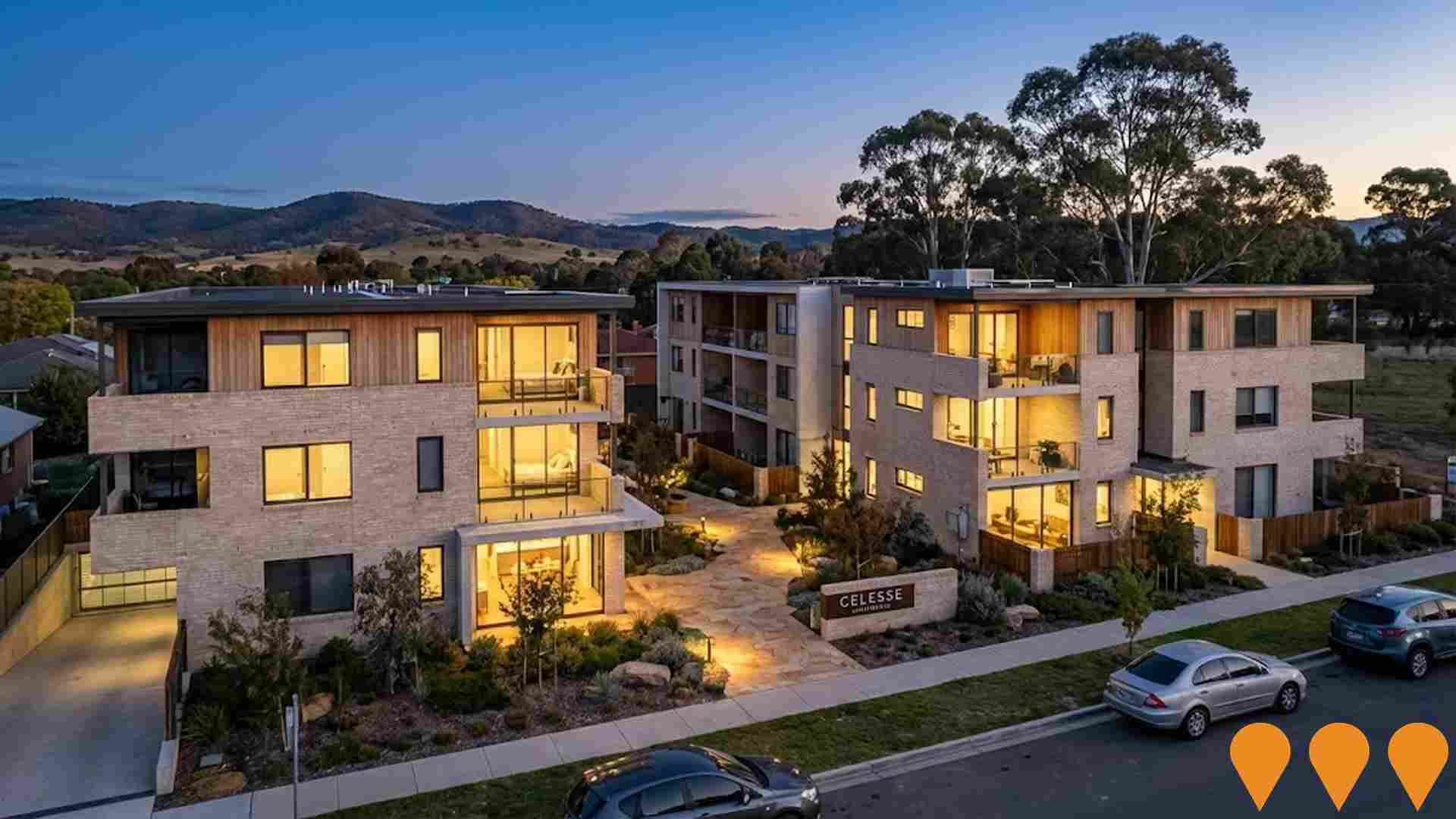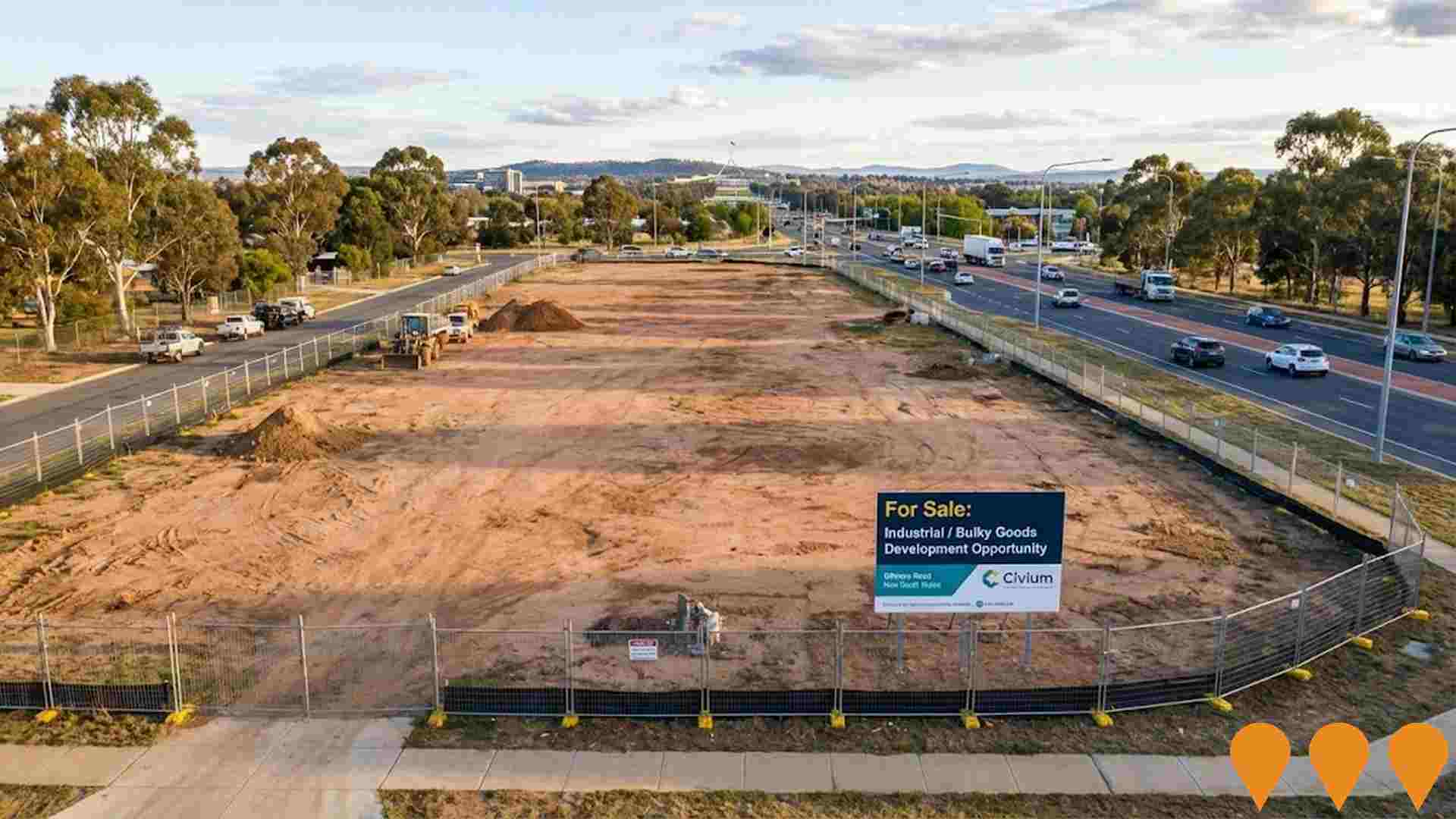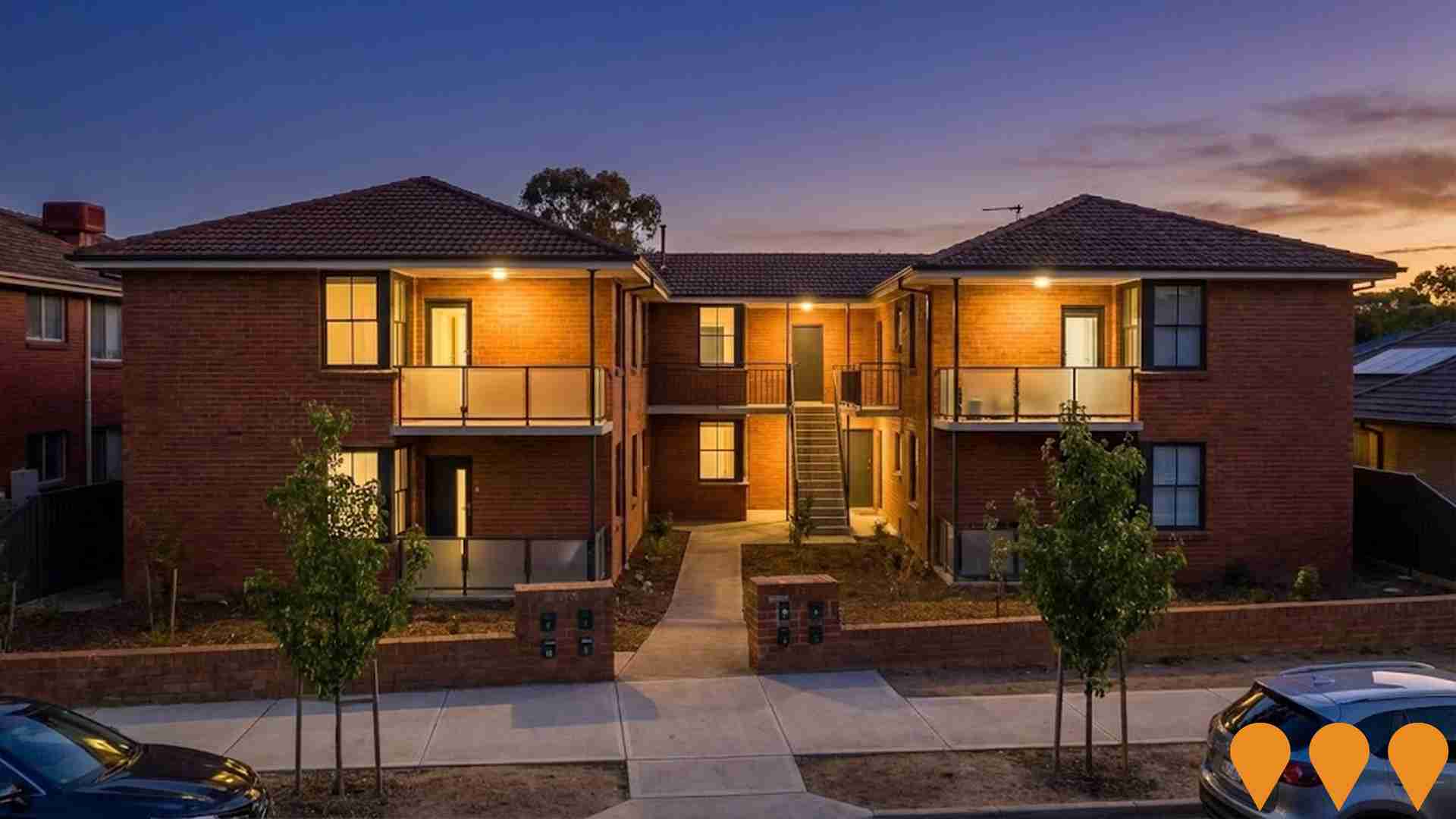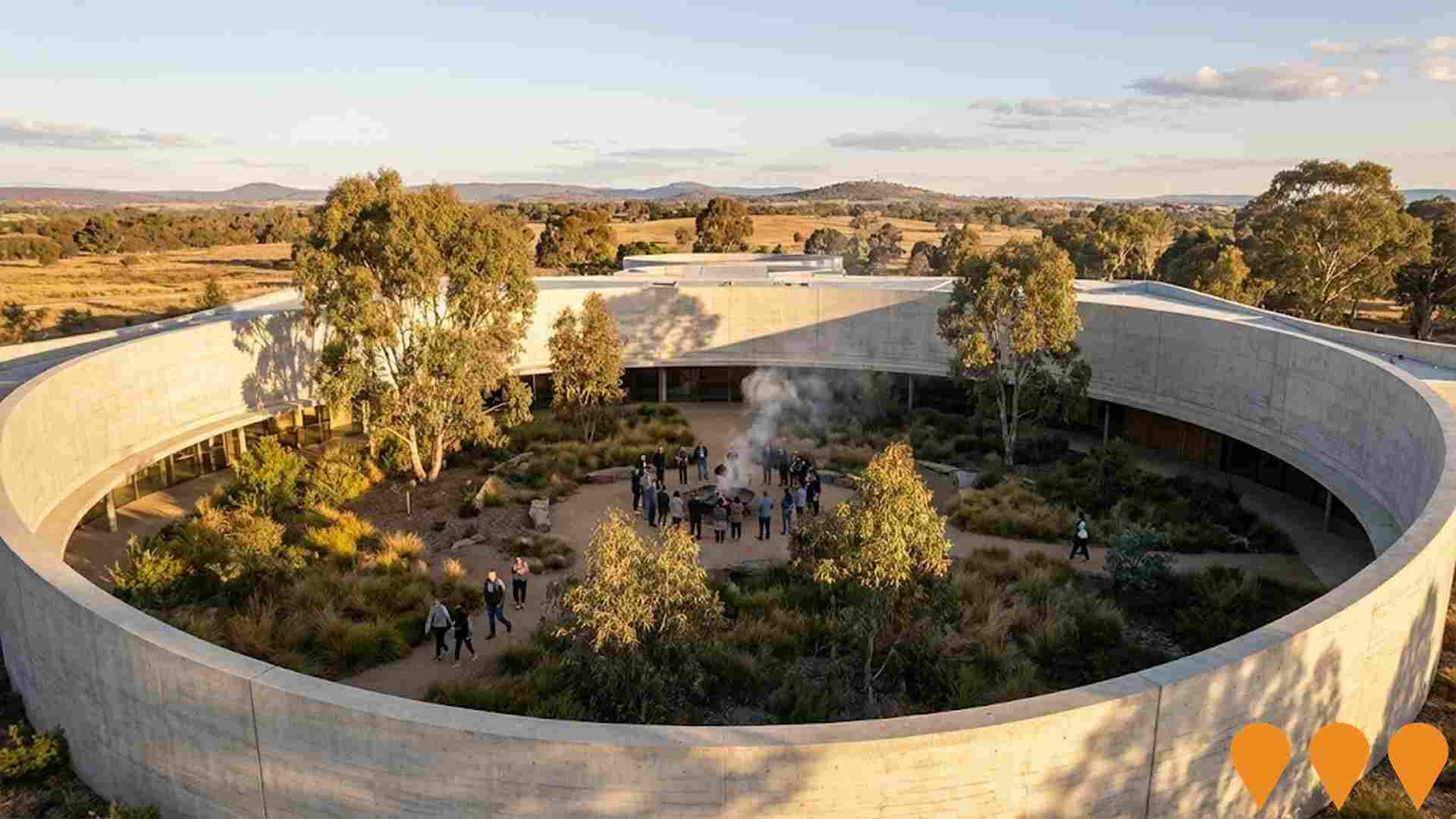Chart Color Schemes
est. as @ -- *
ABS ERP | -- people | --
2021 Census | -- people
Sales Activity
Curious about local property values? Filter the chart to assess the volume and appreciation (including resales) trends and regional comparisons, or scroll to the map below view this information at an individual property level.
Find a Recent Sale
Sales Detail
Population
Population growth drivers in Queanbeyan are strong compared to national averages based on AreaSearch's ranking of recent, and medium to long-term trends
Queanbeyan's population, as of November 2025, is approximately 11,385. This figure represents an increase from the 2021 Census total of 11,342 people, a rise of 43 individuals (0.4%). The ABS estimated resident population in June 2024 was 11,373, with an additional 54 validated new addresses since the Census date contributing to this growth. This results in a population density ratio of 2,391 persons per square kilometer, placing Queanbeyan in the upper quartile relative to other locations assessed by AreaSearch. Overseas migration accounted for approximately 73.4% of overall population gains during recent periods.
AreaSearch is using ABS/Geoscience Australia projections for each SA2 area, released in 2024 with a base year of 2022. For areas not covered by this data, AreaSearch employs the NSW State Government's SA2 level projections, released in 2022 with a base year of 2021. Growth rates by age group from these aggregations are applied to all areas for years 2032 to 2041. Based on demographic trends and latest population numbers, Queanbeyan is forecasted to experience significant growth in the top quartile of Australian non-metropolitan areas. By 2041, the area's population is expected to increase by 3,295 persons, representing a total gain of 28.8% over the 17-year period.
Frequently Asked Questions - Population
Development
The level of residential development activity in Queanbeyan is very low in comparison to the average area assessed nationally by AreaSearch
Queanbeyan has averaged approximately 14 new dwelling approvals annually over the past five financial years, totalling 73 homes. As of FY26, 65 approvals have been recorded. The population decline in recent years has maintained adequate housing supply relative to demand, resulting in a balanced market with good buyer choice. New properties are constructed at an average value of $324,000.
This financial year has seen $30.7 million in commercial approvals, indicating robust local business investment. Compared to the Rest of NSW, Queanbeyan shows significantly reduced construction activity, being 84.0% below the regional average per person. This limited new supply generally supports stronger demand and values for established properties. The area's development activity is also under the national average, suggesting its established nature and potential planning limitations. New development consists of 50.0% detached houses and 50.0% attached dwellings, offering affordable entry pathways and attracting downsizers, investors, and first-time purchasers. There are approximately 1400 people per dwelling approval in the location, demonstrating an established market.
Population forecasts indicate Queanbeyan will gain 3,283 residents by 2041. If current construction levels persist, housing supply may lag population growth, potentially intensifying buyer competition and driving price growth.
Frequently Asked Questions - Development
Infrastructure
Queanbeyan has strong levels of nearby infrastructure activity, ranking in the top 40% nationally
Changes to local infrastructure significantly impact an area's performance. AreaSearch identified ten projects likely affecting the region. Notable ones include Spotlight Queanbeyan Retail Redevelopment, Yass Road upgrade, Bungendore Road and Ellerton Drive intersection improvement, Queanbeyan East Public Preschool construction, and 202 Crawford Street Apartments development. The following list details those most relevant.
Professional plan users can use the search below to filter and access additional projects.
INFRASTRUCTURE SEARCH
 Denotes AI-based impression for illustrative purposes only, not to be taken as definitive under any circumstances. Please follow links and conduct other investigations from the project's source for actual imagery. Developers and project owners wishing us to use original imagery please Contact Us and we will do so.
Denotes AI-based impression for illustrative purposes only, not to be taken as definitive under any circumstances. Please follow links and conduct other investigations from the project's source for actual imagery. Developers and project owners wishing us to use original imagery please Contact Us and we will do so.
Frequently Asked Questions - Infrastructure
Queanbeyan Sewage Treatment Plant Upgrade
The project involves replacing the existing sewage treatment plant, which is nearing the end of its service life and is currently overloaded, with a new modern facility. The upgrade will increase the treatment capacity to service 75,000 equivalent people (EP), with the potential for future expansion to 112,500 EP. The new plant will feature an advanced treatment process including biological nutrient removal, tertiary filtration, and UV disinfection, which will improve the quality of treated effluent discharged into the Molonglo River. A development application for the project was lodged with the ACT Government on December 7, 2023.
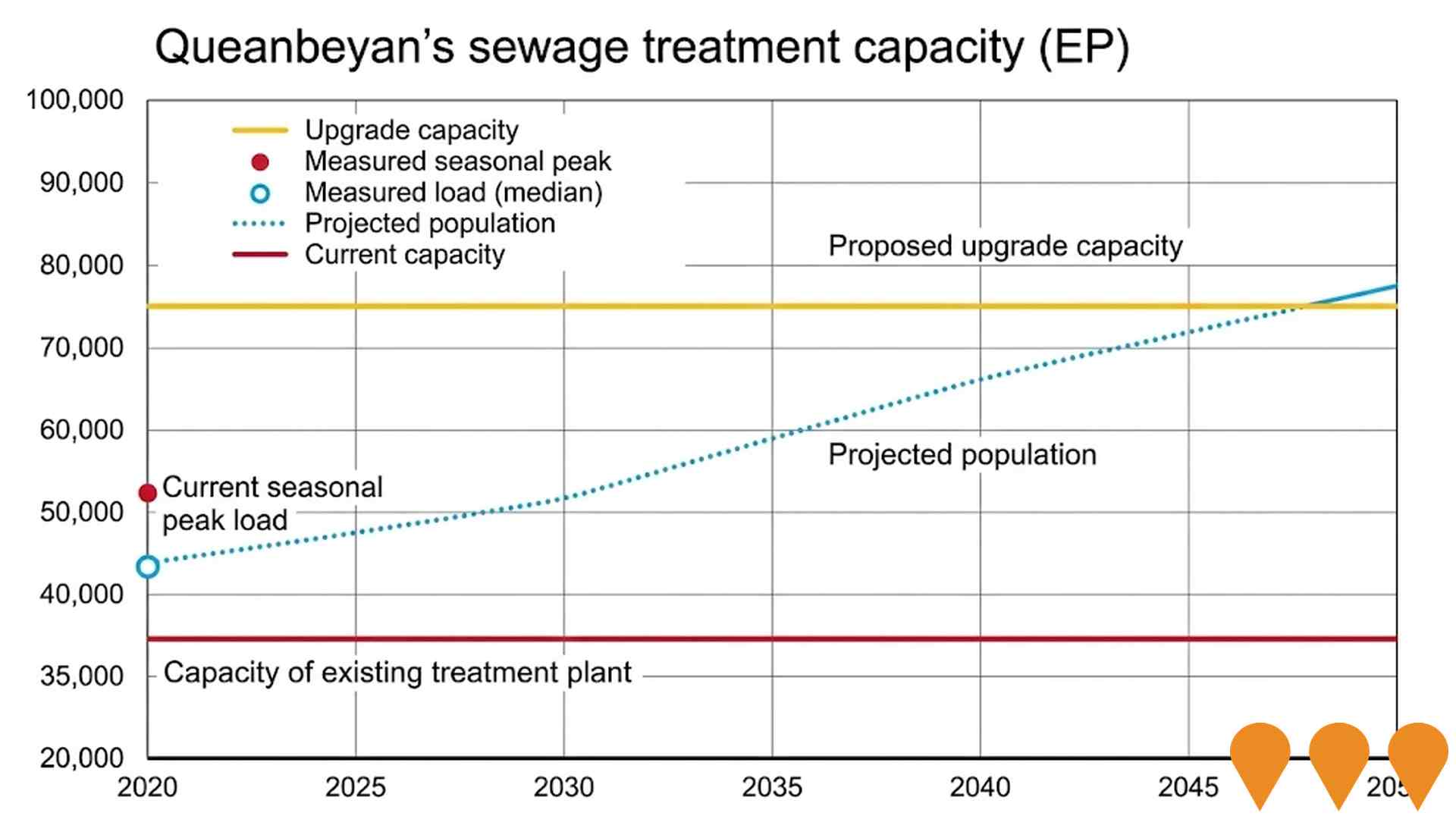
Spotlight Queanbeyan Retail Redevelopment
A mixed-use redevelopment that includes a new 1,000sqm large-format retail store for Supercheap Auto, an extended car park, and various site upgrades. The project is a collaboration between Spotlight Property Group and HGW Projects.

South Jerrabomberra Urban Release Area
A master-planned urban development featuring approximately 1500 residential dwellings, business parks, industrial estates, innovation precincts, regional sports complex, intermodal transport hub, new high school, and community amenities including parks, sports facilities, and retail spaces to create a sustainable community on the NSW-ACT border.
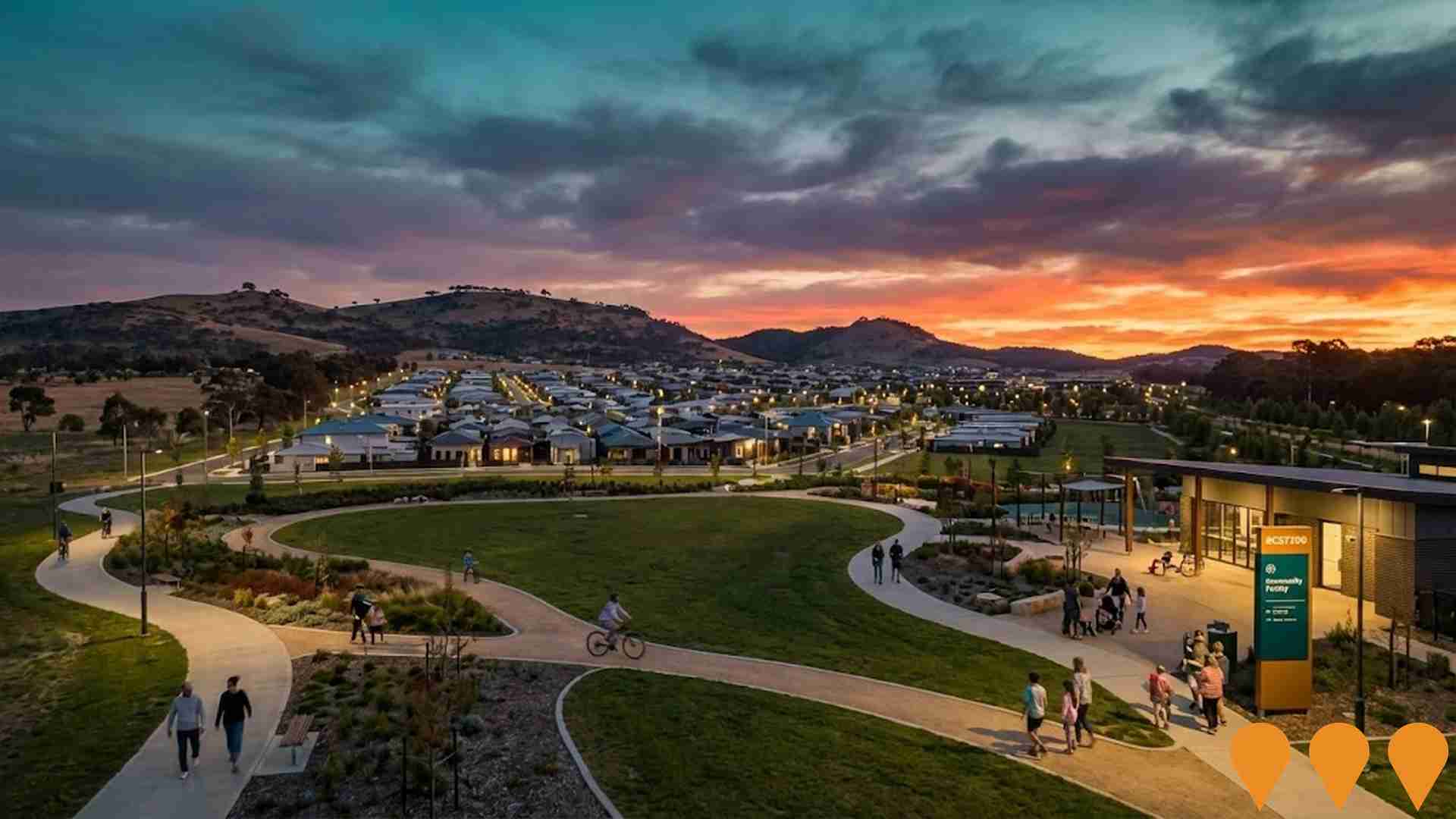
Poplars Innovation Precinct
A 30ha innovation campus focused on high-tech businesses in defense, space, cyber-security, and manufacturing. It includes a 10ha retail and services precinct with national brands, a learning precinct featuring Jerrabomberra High School (completed in 2024), and protected grassland areas under NSW Biodiversity Stewardship Agreements. The precinct is part of the South Jerrabomberra Regional Job Precinct, endorsed by the NSW Government and Queanbeyan-Palerang Regional Council. Key developments include a $71 million Satellite Manufacturing Hub and a 25MW DCI Data Centre operational since 2024. Stage 1 lots are sold or under offer, with Stage 2 opportunities coming soon.
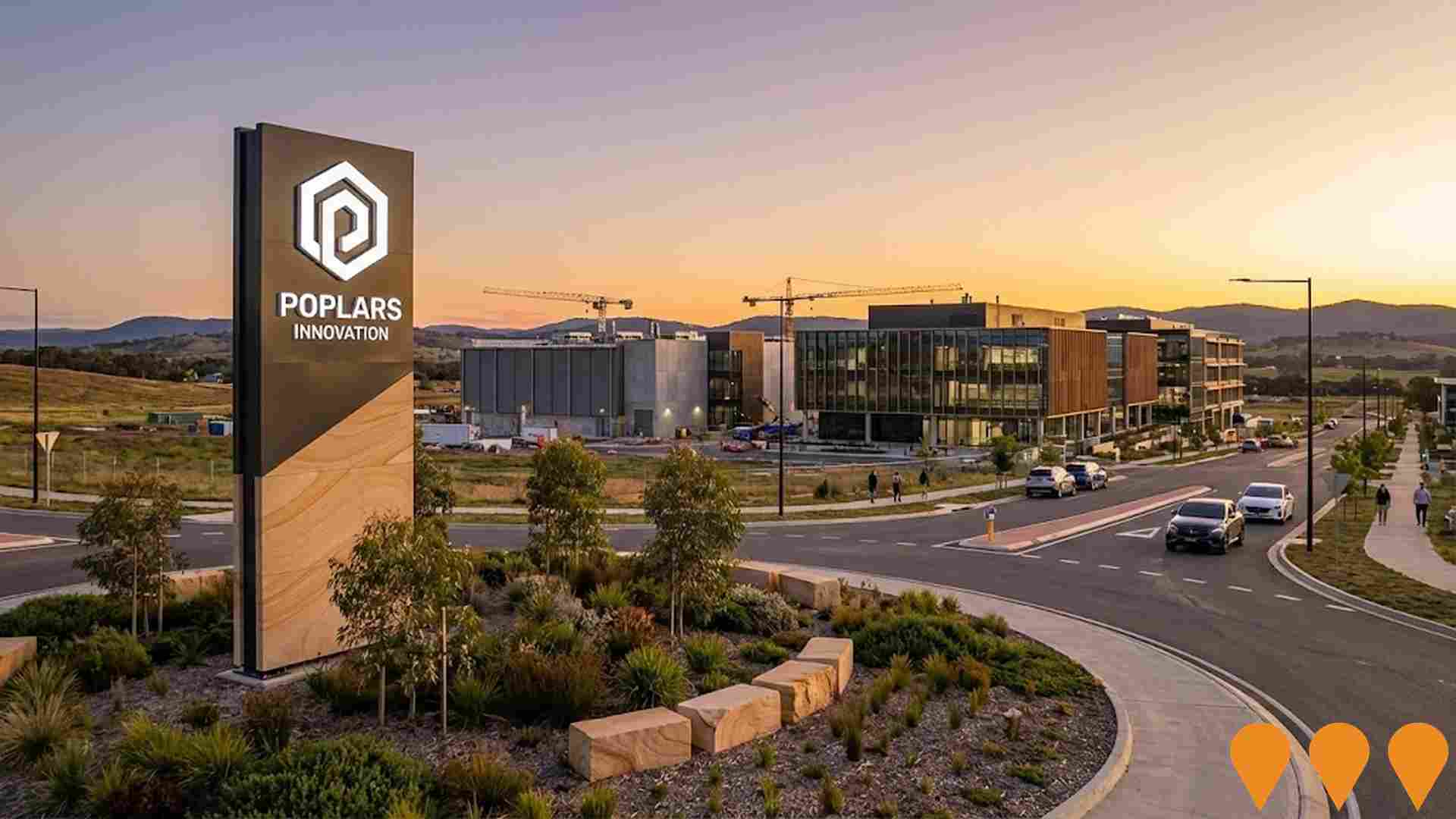
Enhanced bus and light rail corridors (Belconnen & Queanbeyan to Central Canberra)
ACT is progressing an integrated program to enhance high-frequency bus and future light rail corridors that link Belconnen and Queanbeyan with central Canberra. Light Rail Stage 2A (City to Commonwealth Park) commenced construction in early 2025 with services targeted from 2028, while planning and approvals continue for Stage 2B to Woden. The ACT Government has acknowledged and is planning upgrades for the Belconnen-to-City bus corridor as groundwork for a future east-west light rail Stage 3, and is coordinating cross-border public transport initiatives with NSW through the Queanbeyan Region Integrated Transport Plan and the ACT-NSW MoU for Regional Collaboration.
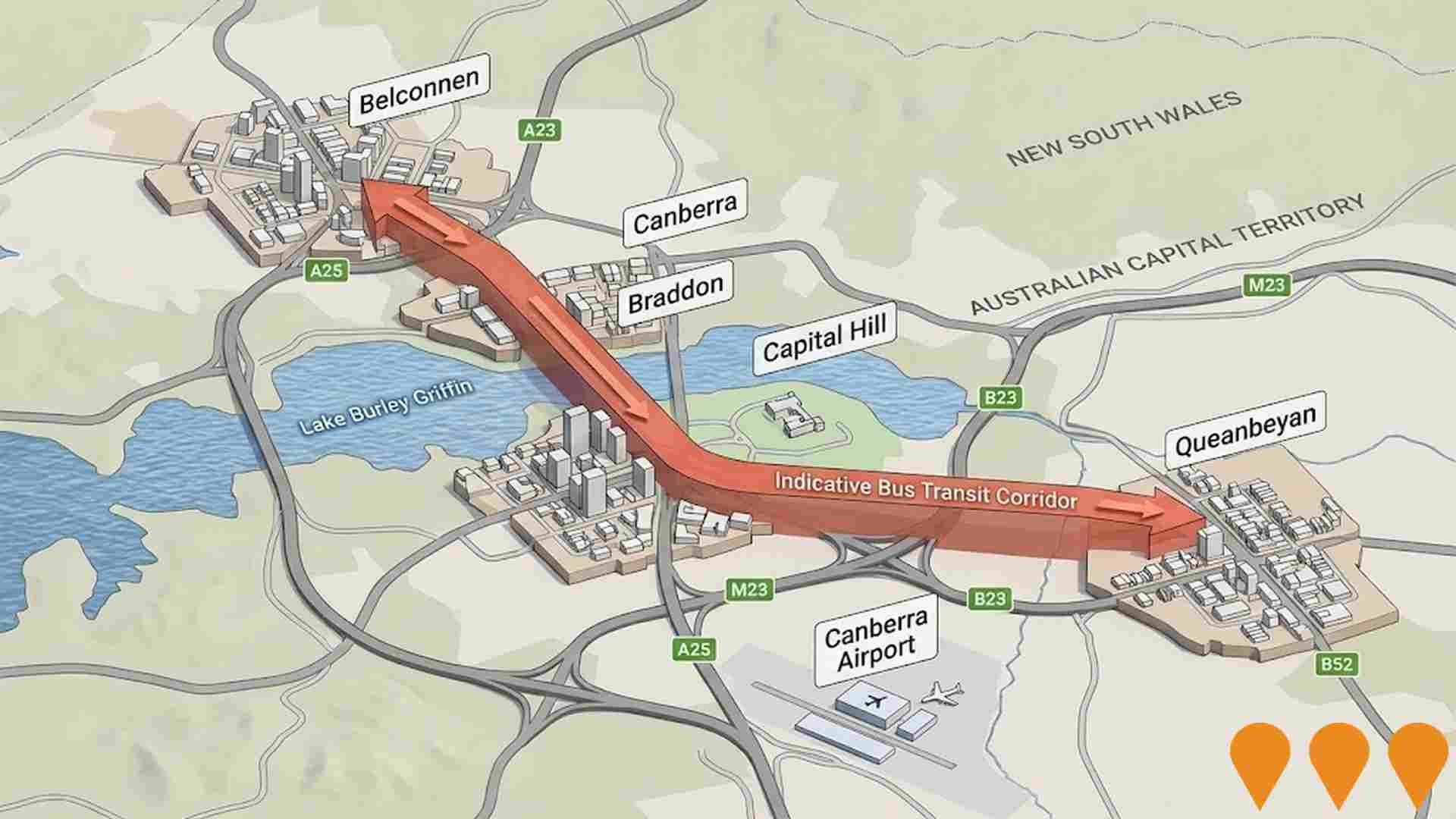
Queanbeyan Regional Integrated Transport Plan
Comprehensive transport planning initiative with 64 key actions for next 10 years. Addresses road safety, active transport connectivity, public transport availability, and future transport needs. Improved connections between Queanbeyan and ACT.
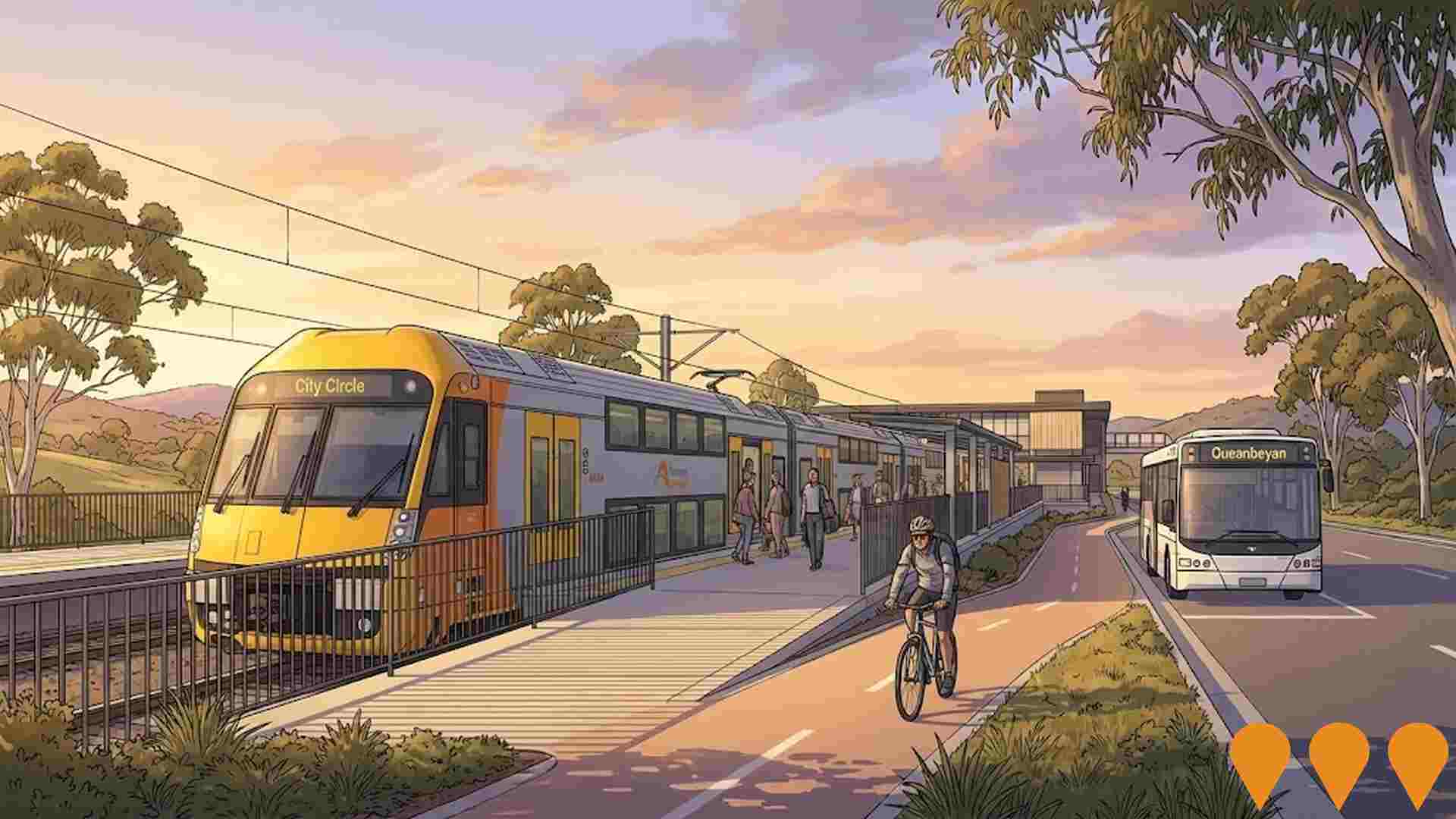
Queanbeyan East Public Preschool
The new public preschool will be located at Queanbeyan East Public School as part of the NSW Government's plan to deliver 100 new public preschools by 2027. It is designed to be a safe and engaging environment for preschool children, featuring two preschool rooms and an outdoor play area. The preschool will accommodate up to 40 children per day and is expected to be completed in time for Day 1, Term 1, 2027. Zauner Construction Pty Ltd has been awarded the contract to deliver the project. Statutory planning documentation is expected to be submitted in the coming months, and a construction start date will be confirmed after planning approval is received.

Yass Road, Bungendore Road and Ellerton Drive Intersection Upgrade
Major intersection upgrade replacing the existing roundabout with traffic signals. Includes two through lanes in all directions, dedicated left and right turn lanes on all approaches, signalised pedestrian crossings on all legs, on-road cycle lanes on Ellerton Drive and Yass Road, removal of the pedestrian underpass, upgraded footpaths, and relocation of bus stops. Designed to improve safety, reduce congestion, and enhance pedestrian and cyclist connectivity. Community consultation completed in 2025 with over 1,000 submissions and approximately 80% support. Geotechnical investigations completed August 2025. NSW Government funding approximately $33.7 million.

Employment
Employment performance in Queanbeyan exceeds national averages across key labour market indicators
Queanbeyan has a well-educated workforce with prominent essential services sectors. Its unemployment rate is 2.7%.
As of June 2025, 6825 residents are employed, with an unemployment rate of 1.0% below the Rest of NSW's rate of 3.7%. Workforce participation in Queanbeyan is 67.9%, higher than the Rest of NSW's 56.4%. Major employment sectors include public administration & safety, health care & social assistance, and construction. Public administration & safety has a particularly high share at 3.2 times the regional level, while agriculture, forestry & fishing employs only 0.3% of local workers, lower than the Rest of NSW's 5.3%.
Many residents commute elsewhere for work based on Census data analysis. Between June 2024 and June 2025, Queanbeyan's labour force decreased by 3.6%, employment declined by 4.3%, leading to a 0.7 percentage point rise in unemployment rate. In contrast, the Rest of NSW saw employment contract by 0.1%, labour force grow by 0.3%, and unemployment rise by 0.4 percentage points. Jobs and Skills Australia's national employment forecasts from May 2025 project total employment growth of 6.6% over five years and 13.7% over ten years. Applying these projections to Queanbeyan's employment mix suggests local growth of approximately 6.2% over five years and 12.8% over ten years, though this is a simple extrapolation for illustrative purposes only.
Frequently Asked Questions - Employment
Income
Income analysis reveals strong economic positioning, with the area outperforming 60% of locations assessed nationally by AreaSearch
AreaSearch's aggregation of ATO data for financial year 2022 shows Queanbeyan had a median taxpayer income of $57,952 and an average of $68,228. This is higher than the national averages of $49,459 and $62,998 respectively in Rest of NSW. Based on Wage Price Index growth from financial year 2022 to September 2025 (12.61%), estimated median income is approximately $65,260 and average is $76,832. Census data indicates personal income ranks at the 78th percentile ($996 weekly) and household income at the 47th percentile. Income distribution shows 36.1% (4,109 individuals) in the $1,500 - $2,999 band, consistent with regional trends of 29.9%. Housing affordability pressures are severe, with only 83.9% of income remaining, ranking at the 48th percentile. Queanbeyan's SEIFA income ranking places it in the 5th decile.
Frequently Asked Questions - Income
Housing
Queanbeyan displays a diverse mix of dwelling types, with a higher proportion of rental properties than the broader region
Queanbeyan's dwelling structure, as per the latest Census evaluation, consisted of 41.8% houses and 58.2% other dwellings (semi-detached, apartments, 'other' dwellings), compared to Non-Metro NSW's 74.5% houses and 25.5% other dwellings. Home ownership in Queanbeyan was at 23.3%, with mortgaged dwellings at 32.4% and rented ones at 44.3%. The median monthly mortgage repayment in the area was $1,700, lower than Non-Metro NSW's average of $2,167. The median weekly rent figure was recorded at $330, compared to Non-Metro NSW's $355. Nationally, Queanbeyan's mortgage repayments were lower than the Australian average of $1,863, and rents were substantially below the national figure of $375.
Frequently Asked Questions - Housing
Household Composition
Queanbeyan features high concentrations of lone person households, with a lower-than-average median household size
Family households constitute 54.7% of all households, including 21.0% couples with children, 22.2% couples without children, and 10.1% single parent families. Non-family households account for the remaining 45.3%, with lone person households at 41.9% and group households comprising 3.4% of the total. The median household size is 2.1 people, smaller than the Rest of NSW average of 2.6.
Frequently Asked Questions - Households
Local Schools & Education
Educational attainment in Queanbeyan aligns closely with national averages, showing typical qualification patterns and performance metrics
Queanbeyan's educational profile is notable within its region, with 31.2% of residents aged 15+ holding university qualifications, exceeding the Rest of NSW average of 21.3%. This rate also surpasses that of the SA4 region at 24.1%, indicating a community emphasis on higher education. Bachelor degrees are most prevalent at 17.9%, followed by postgraduate qualifications (10.5%) and graduate diplomas (2.8%).
Vocational credentials are prominent, with 31.9% of residents aged 15+ holding such qualifications, including advanced diplomas (10.5%) and certificates (21.4%). Educational participation is high, with 26.6% of residents currently enrolled in formal education. This includes 8.0% in primary education, 5.4% in tertiary education, and 5.1% pursuing secondary education. Queanbeyan's five schools have a combined enrollment reaching 1,385 students, with typical Australian school conditions (ICSEA: 1005) and balanced educational opportunities. The educational mix includes three primary, one secondary, and one K-12 school. School capacity exceeds residential needs, with 12.2 places per 100 residents compared to the regional average of 10.1, suggesting Queanbeyan serves as an educational hub for the broader region.
Frequently Asked Questions - Education
Schools Detail
Nearby Services & Amenities
Transport
Transport servicing is good compared to other areas nationally based on assessment of service frequency, route connectivity and accessibility
Queanbeyan has 56 active public transport stops operating within the city. These stops offer a mix of train and bus services. There are 110 individual routes serving these stops, collectively providing 3,894 weekly passenger trips.
The accessibility to public transport is rated as excellent, with residents typically located 160 meters from the nearest stop. On average, there are 556 trips per day across all routes, which equates to approximately 69 weekly trips per individual stop.
Frequently Asked Questions - Transport
Transport Stops Detail
Health
Health performance in Queanbeyan is lower than average with common health conditions somewhat prevalent across the board, though to a considerably higher degree among older age cohorts
Queanbeyan faces significant health challenges with common health conditions being somewhat prevalent across all age groups but to a higher degree among older adults. Approximately 54% of Queanbeyan's total population (~6,113 people) have private health cover, compared to 61.0% in the rest of NSW.
Mental health issues and arthritis are the most common medical conditions in Queanbeyan, affecting 10.2% and 8.5% of residents respectively. About 66.5% of residents claim to be completely free from medical ailments, compared to 68.7% in the rest of NSW. The area has a senior population (aged 65 and over) of 14.2%, comprising 1,614 people. Health outcomes among seniors require more attention than those in the broader population.
Frequently Asked Questions - Health
Cultural Diversity
Queanbeyan was found to be more culturally diverse than the vast majority of local markets in Australia, upon assessment of a range of language and cultural background related metrics
Queanbeyan's population showed greater cultural diversity compared to most other local areas, with 28.3% born overseas and 24.4% speaking a language other than English at home. Christianity was the predominant religion in Queanbeyan, accounting for 47.1% of its population. The 'Other' religious category had a higher representation in Queanbeyan at 3.2%, compared to the Rest of NSW's 1.6%.
In terms of ancestry, the top three groups were Australian (23.8%), English (23.2%), and Other (13.0%), with the latter being significantly higher than the regional average of 7.9%. Certain ethnic groups showed notable differences in representation: Macedonian at 2.0% compared to the regional 1.5%, Serbian at 0.7% versus 0.6%, and Croatian at 0.9% matching the regional figure.
Frequently Asked Questions - Diversity
Age
Queanbeyan's population is slightly younger than the national pattern
The median age in Queanbeyan is 36 years, which is significantly lower than Rest of NSW's average of 43 years and somewhat younger than Australia's median age of 38 years. The 25-34 age group comprises 22.9% of Queanbeyan's population, compared to Rest of NSW, while the 65-74 cohort makes up 7.2%. This proportion of individuals aged 25-34 is well above the national average of 14.5%. According to data from the 2021 Census, the 25-34 age group has increased from 20.9% to 22.9%, and the 35-44 cohort has risen from 14.5% to 15.9%. Conversely, the 5-14 age group has decreased from 9.4% to 8.2%, and the 65-74 group has fallen from 8.2% to 7.2%. Population forecasts for Queanbeyan in 2041 indicate substantial demographic changes. The 25-34 age group is projected to grow by 42%, adding 1,086 people and reaching a total of 3,694 from the current 2,607. In contrast, the 55-64 cohort is expected to show minimal growth of just 1%, increasing by only 12 people.
